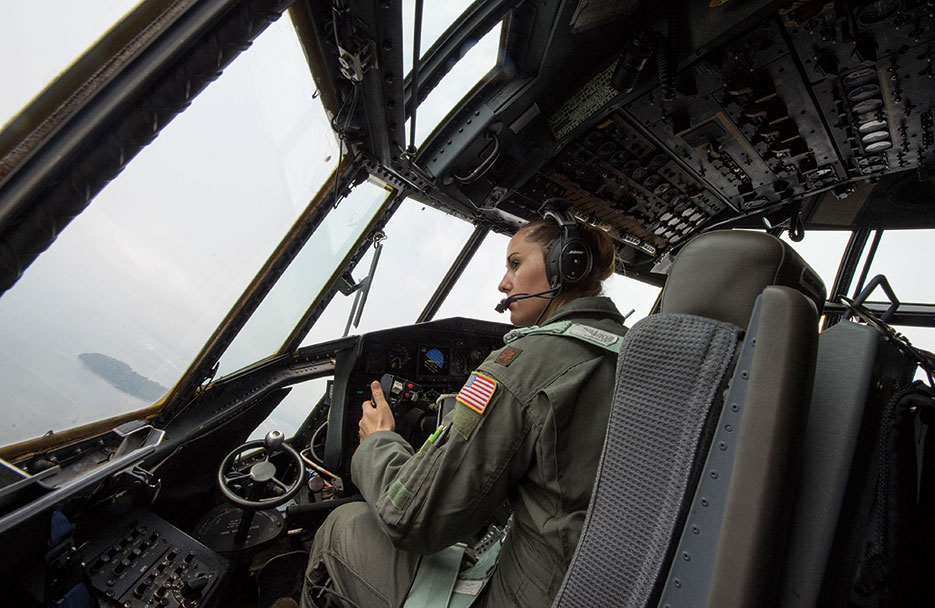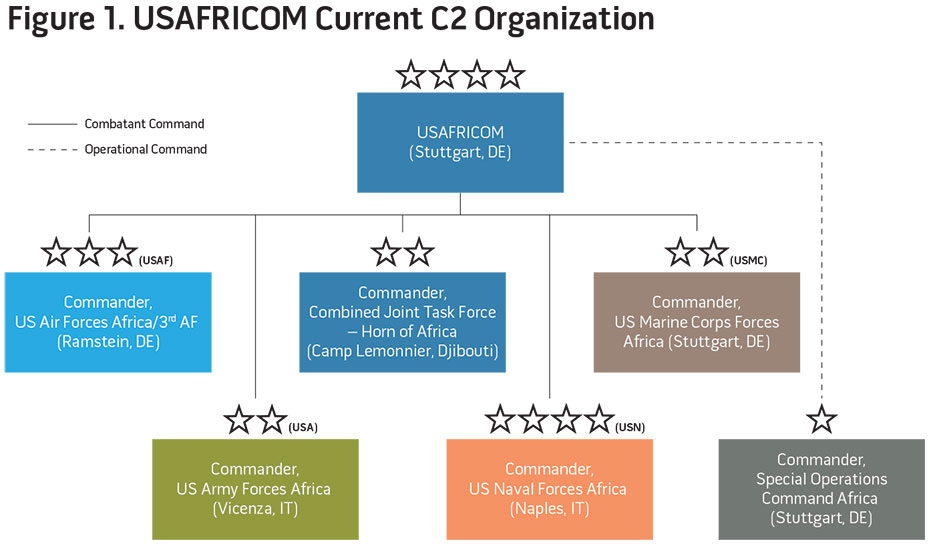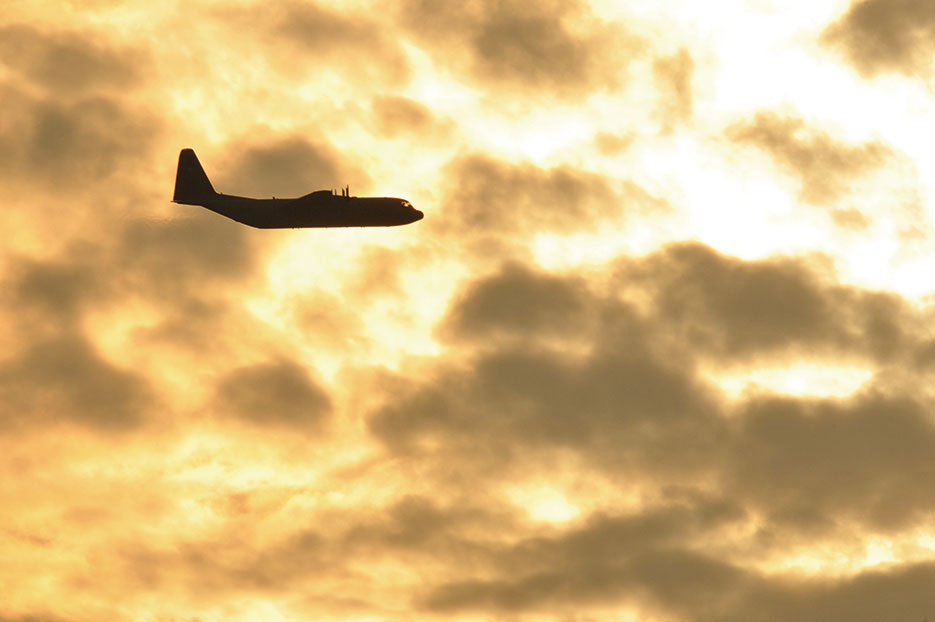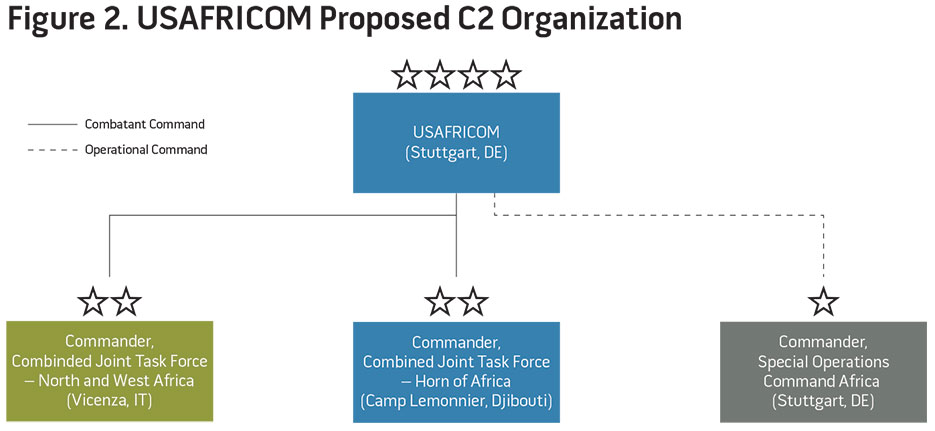Commander Michael G. Kamas, USN, is the prospective Executive Officer of the Maritime Patrol and Reconnaissance Weapons School. Major David W. Pope, USMC, is an Action Officer in the Multinational Cooperation Center at U.S. Africa Command. Major Ryan N. Propst, USA, is the Air and Missile Defense Chief for the Army's 1st Infantry Division.
The Senate Armed Services Committee (SASC) proposed several changes to improve the organization of the combatant commands (CCMDs) in its markup of the National Defense Authorization Act (NDAA) for Fiscal Year 2017. The first provision seeks to focus the CCMDs on their primary warfighting mission supporting the National Defense Strategy, limiting CCMD participation in other important, but nonessential, mission sets. A second proposal would “require the Secretary of Defense to conduct a pilot program on an alternative organizational structure at one combatant command . . . replacing the Service component commands with joint task forces [JTFs] focused on operational military missions. The Committee believes that this could provide lessons for improving the integration of operational efforts across the command, streamlining unnecessary layers of management, and reducing the number of staff.”1 Converting the command and control (C2) structure of a geographic CCMD from a group of Service component commands to a set of JTFs is achievable, despite congressionally mandated reductions in headquarters staff personnel and lack of a major combat operation in theater. While the final version of the NDAA removed this requirement, U.S. Africa Command (USAFRICOM) would have been the ideal CCMD to test and evaluate this new C2 structure.

Airman with 731st Airlift Squadron pilots C-130 Hercules as part of U.S. Army Africa Exercise Central Accord 2016, in Libreville, Gabon (DOD/ Brian Kimball)
The Goldwater-Nichols Department of Defense Reorganization Act of 1986 provided the impetus for several organizational changes that are still evident today. While many associate Goldwater-Nichols with the mandate to end parochialism within the individual Services through new emphasis on “jointness,” the legislation also provided greater command authority for the unified and specified combatant commands. Geographic combatant commanders now report directly to the Secretary of Defense instead of falling under the Chairman of the Joint Chiefs of Staff. The Service chiefs would provide training, manpower, and equipment for the joint force, allocated and apportioned under the operational control of a combatant commander. As Secretary of Defense Chuck Hagel stated in a 2013 speech, “Goldwater-Nichols succeeded in its purpose by strengthening the Joint Staff and the Combatant Commands, but it went about doing this by layering joint organizations and processes atop service organizations and atop processes. The elevation of the former did not automatically lead to the diminution of the latter.”2
Proponents of Goldwater-Nichols reform argue that changes to warfare in a complex world require a different approach to military command and control. Secretary of Defense Ashton Carter stated, “Updates are needed in the Combatant Commands, adapting them to new functions, including cyber, and continuing to aggressively streamline headquarters.”3 In an era where warfare has shifted from conventional nation-against-nation conflict to a more unpredictable set of interrelated conflicts between state and nonstate actors, perhaps geographic boundaries are no longer the most effective way to organize the C2 structure of military operations.
In August 2016, the Joint Staff J7 Deployable Training Division published the second edition of a focus paper titled “Geographic Combatant Commander (GCC) Command and Control Organizational Options,” which analyzes several C2 alternatives available to the unified combatant commanders during steady-state or crisis operations. Traditionally, a CCMD consists of subordinate commands that could be grouped into three categories: Service components, subunified commands, and functional components. There is not a standard template on how each CCMD must organize, but the C2 structure broadly utilizes a set of Service component subordinate commands and an additional special operations component to execute the CCMD’s mission. The J7 paper also analyzes three additional options for a CCMD’s C2 structure: a single Service force, JTFs, and specific operational forces.4
The JTF option is not without precedent as it has been successfully executed in the years following the passage of Goldwater-Nichols legislation. Operation Just Cause in 1989 was the first success story of a JTF operating under the authority of U.S. Southern Command in Panama. Today, the Combined Joint Task Force–Horn of Africa (CJTF-HOA) is an example of a combined joint task force (CJTF) subordinate to USAFRICOM, which has been charged with oversight and execution of counterterrorism missions in Somalia and the broader East Africa region. The J7 paper provides significant guidance on when the employment of a JTF or CJTF option could prove advantageous. These reasons include a “single mission focus and resultant close integration/C2 of forces and the freedom for the GCC to maintain a wide focus of the CCMD area of responsibility (AOR) through deliberate delegation of authority to the JTF commander.”5 Although JTFs were designed to be limited in duration, that paradigm has shifted in recent years as demonstrated by enduring JTFs such as CJTF-HOA and JTF-Guantanamo.

Since the proposed 2017 NDAA from the SASC would require one of the geographic combatant commands to evaluate the alternative JTF option, the existence of CJTF-HOA and the broad mission set of USAFRICOM make it the ideal place to test this C2 structure. Although USAFRICOM covers a large continent and is engaged in over 15 named operations, it is an economy of force command with limited assigned forces that relies on force allocation and force sharing agreements with U.S. European Command (USEUCOM) to execute its mission. USAFRICOM has six subordinate component commands, three of which are shared with USEUCOM (see figure 1).
- U.S. Air Forces Africa (USAFAF) is a Service component command dual-hatted as U.S. Air Forces Europe, headquartered at Ramstein Air Base, Germany. It provides forward-based airpower and infrastructure to execute operations in Europe and Africa and also supports North Atlantic Treaty Organization air operations and planning.
- U.S. Army Africa (USARAF), formerly called the Southern European Task Force, provides mission command and employs forces to set the theater, conduct security force assistance, and provide support to USAFRICOM land operations in Africa. USARAF is located at Vincenza, Italy.
- Combined Joint Task Force–Horn of Africa is a multinational task force designed to fight violent extremist organizations in East Africa through power projection and by building the defense capability and capacity of international partners. CJTF-HOA is based at Camp Lemonnier, Djibouti.
- U.S. Marine Corps Forces Africa (MARFORAF) also has the role of U.S. Marine Corps Forces Europe and is headquartered at Stuttgart, Germany. MARFORAF maintains a Special Purpose Marine Air-Ground Task Force–Crisis Response (SPMAGTF-CR) in the USAFRICOM AOR.
- U.S. Naval Forces Africa (USNAVAF), sharing the role of U.S. Naval Forces Europe (USNAVEUR), also serves as Naval Support Activity Naples, in Naples, Italy. USNAVAF/USNAVEUR maintains the U.S. Sixth Fleet, which consists of permanent and rotational naval forces to conduct ballistic missile defense and other missions within its AOR.
- Special Operations Command Africa (SOCAFRICA) is a functional, subunified command in Stuttgart, which serves as the Theater Special Operations Command (TSOC). While USAFRICOM is granted operational control (OPCON) of the TSOC, U.S. Special Operations Command (USSOCOM) maintains combatant command authority.
Of these six subordinate commands to USAFRICOM, only half are singularly focused on a specific mission inside the USAFRICOM AOR. For the purposes of converting USAFRICOM to a series of JTFs, CJTF-HOA and SOCAFRICA would remain largely intact.
It could be argued that U.S. Southern Command (USSOUTHCOM), like USAFRICOM, maintains a diverse mission set, with no near-peer U.S. competitors within its AOR, and is just as well suited to serve as the pilot CCMD to evaluate the NDAA’s proposed C2 structure. USSOUTHCOM currently has three JTFs within its organizational structure as well as the requisite Service component commands, with a large emphasis on theater security cooperation activities.6 The USSOUTHCOM JTFs are Joint Task Force–Bravo, at Soto Cano Air Base, Honduras; JTF-Guantanamo; and Joint Interagency Task Force–South, in Key West, Florida. But unlike USAFRICOM, USSOUTHCOM is not challenged by the fact that three of its four component commands are dual-hatted to support another CCMD. Each Service component command at USSOUTHCOM serves only one combatant commander, and those components have closer proximity and reach-back to forces based in the continental United States. Additionally, USSOUTHCOM’s AOR is not as rife with violent extremist organizations (VEOs), which pose a direct threat to U.S. interests, our allies, and regional stability. USAFRICOM’s one standing joint task force—CJTF-HOA—is focused on combating terrorism and providing stability in East Africa. For these reasons, it would be most logical to expand the JTF structure in USAFRICOM’s AOR, as opposed to USSOUTHCOM’s AOR. To assess the requirements for additional JTFs across the African continent, a basic understanding of the USAFRICOM theater campaign plan (TCP) is required.

U.S. Air Force C-130 Hercules flies over Hopfenohe Drop Zone while conducting static line airborne operations with paratroopers assigned to Special Operations Command Africa at 7th Army Joint Multinational Training Command’s Grafenwoehr Training Area, Germany, September 25, 2013 (U.S. Army/ Markus Rauchenberger)
USAFRICOM’s Theater Campaign Plan
Published in August 2015, the USAFRICOM TCP is a 5-year plan intended to set conditions for achieving the 10-year regional endstates described in the 2015 USAFRICOM theater strategy. The 5-year campaign mission statement is as follows: “USAFRICOM, with partners, disrupts and neutralizes transnational threats, protects U.S. personnel and facilities, prevents and mitigates conflict, and builds African partner defense capability and capacity in order to promote regional security, stability, and prosperity.”7 To meet mission requirements, the plan defines decisive, shaping, and sustaining efforts for campaign execution. Decisive efforts are those “focused on building African partner capacity and strengthening partnerships.”8
The shaping effort is focused on disrupting and degrading VEOs to set the conditions for success of the decisive effort in time. Sustaining efforts support the other two efforts by ensuring the force and theater are set for the campaign. The campaign lists five lines of effort (LOEs), each with supporting intermediate objectives (IMOs), tied to the plan’s endstates. These LOEs are listed in priority order, and other than LOE 5, they can be attached to a specific geographic area.
- LOE 1. Neutralize al Shabaab/transition African Union Mission in Somalia
- LOE 2. Degrade violent extremist organizations in Sahel-Maghreb/contain instability in Libya
- LOE 3. Contain and degrade Boko Haram
- LOE 4. Interdict illicit activity in Gulf of Guinea/Central Africa
- LOE 5. Build peacekeeping/humanitarian assistance and disaster relief capacity of African partners.9
Structure Challenges in a Resource-Constrained Environment
A key assumption of this proposal is the continued desire to minimize the U.S. military footprint in Africa. The vast size of the continent, African sensitivities to a colonial presence, and the lack of political will to establish a large overseas force structure all serve as contributing factors toward the small U.S. presence. Accomplishment of the USAFRICOM mission relies on Secretary of Defense–approved force allocation, which often involves agreements to share operational forces and posture locations with USEUCOM and U.S. Central Command. Proposed C2 changes should not increase the military presence in Africa, unless it is required for tactical mission execution.
U.S. special operations will continue to play an outsize role in military operations over conventional forces; therefore, SOCAFRICA will maintain its current role as a TSOC.
Lines of effort articulated in the 2015 TCP are anticipated to remain consistent, although proposed C2 changes should have a measured amount of flexibility to address emergent combatant commander priorities, improved capabilities of our regional partners, and unforeseen threats. However, a functional-based JTF structure should not result in any net increase of headquarters personnel.
Because USARAF is the only Service component command that is not shared with USEUCOM, it is ideally suited for conversion to a JTF for North and West Africa. It is natural to assume that USARAF will need additional headquarters personnel to expand its role to a fully operational joint task force. The expansion of administrative staff, planners, and leadership should result from a proportional downsizing of personnel from USAFAF, USNAVAF, and MARFORAF. As stated in Joint Publication (JP) 5-0, Joint Operation Planning, “When a CCDR [combatant commander] is directed to create a JTF headquarters, the CCDR creates a joint manning document, sourced as much as possible from CCMD resources, that is forwarded to JS [Joint Staff] J-1 for JIA [joint individual augmentation] sourcing approval.”10 The manpower shifts should not be made in a vacuum. Service component commands need to provide vital input on what functions and tasks previously performed by staff to support Africa-centric operations should now shift to the new JTF headquarters.
JTF Structure Standup
To support the NDAA’s proposed pilot program, it is recommended that the new subordinate JTF structures be built around existing USAFRICOM TCP LOEs. JP 1-0, Joint Personnel Support, states:
A JTF may be established on a geographical area or functional basis when the mission has a specific limited objective and does not require overall centralized control of logistics. The mission assigned to a JTF requires execution of responsibilities involving a joint force on a significant scale and close integration of effort, or requires coordination within a subordinate area or local defense of a subordinate area. The establishing authority dissolves a JTF when the purpose for which it was created has been achieved or when it is no longer required.11
LOEs 1 through 4 clearly meet the intent of what a JTF could be used for, as described above, and a JTF in support of these LOEs could allow USAFRICOM to maintain focus across the AOR while a JTF deals specifically with the problem sets inherent in the LOEs, a benefit described in the J7’s August 2016 paper on GCC C2 organizational options.12
CJTF-HOA, as previously described, is already postured to meet objectives in support of LOE 1. Additionally, ongoing programs within their area of operations are supporting LOE 5 objectives. Given that this JTF is focused on the top priority LOE, there is no need to make extreme adjustments to its structure or mission set. LOEs 2 through 4, however, will require a separate and new C2 organization. It is recommended that a new CJTF–North and West Africa (CJTF-NWA) be created in order to address the problem sets that pertain to those regions and LOEs 2 through 4. Like CJTF-HOA, CJTF-NWA would be responsible for coordinating and executing activities in its area of operations that contribute to objectives that fall within LOE 5’s scope. Also, like CJTF-HOA, which serves as a combined JTF, with multinational elements contributing to its staffing and mission execution, the JTF for North and West Africa should be created as a CJTF. As it stands today, the United States and its allies (for example, France, the United Kingdom, Italy) share mutual interests for enduring stability, such as counterterrorism operations, containment of migrant flow, and defense institution building. CJTF-NWA should leverage these shared interests and synchronize partner-nation actions to the benefit of the entire region.
Figure 2 shows the proposed C2 organization for the execution of this pilot program at USAFRICOM. Although each JTF could potentially become disestablished when the JTF’s mission has been accomplished, this model assumes sustained relevance for the next 5 years, which would encompass the length of the C2 evaluation period.

Consistent with its theater campaign plan LOEs, USAFRICOM would accept the risk of not having a JTF focused on the southern region of its AOR. This is mitigated by the fact that this region is relatively stable, has no major VEO threat, and its militaries are mostly capable of internal security. As part of its AOR-wide focus, USAFRICOM will support LOE 5 objectives in this region by planning and coordinating for the use of U.S. Army Regionally Aligned Forces, the Army National Guard State Partnership Program, other military entities, and interagency assets (for example, the U.S. Coast Guard) to meet LOE 5’s associated endstate. Geographic boundaries for CJTF-NWA and CJTF-HOA are illustrated in figure 3.
Proposed JTF C2 Structures and Joint C2 Principles
JP 1-0 states that a joint force commander’s (JFC’s) C2 structure should be centered on its mission, location, and force capabilities, among other things, and the following principles should enable its structure: simplicity, span of control, unit integrity, and interoperability.13
The proposed dual CJTF command structure adheres to the principle of simplicity by establishing distinct objectives, tied to LOEs for each JTF. This enables unity of command and clearly defines roles, responsibilities, and authorities across the AOR not only for each JTF but also for USAFRICOM. As for span of control, CJTF-HOA certainly is compliant; however, CJTF-NWA’s varied problem sets, objectives, and geography will require its planners to consider the scope and size of activities in relation to its force capabilities in the AOR. Conversely, the addition of CJTF-NWA into USAFRICOM’s AOR will support the combatant command’s ability to positively affect its span of control.
Unit integrity is maintained when forces assigned to the JTF align with their designated C2 organization, which maximizes their effectiveness. There are no outstanding issues with unit integrity in the proposed JTF construct; however, JTF commanders with OPCON authority to reorganize assigned units should only do so if there is a compelling case for it. To facilitate interoperability, USAFRICOM will need to ensure shared understanding across its staff and both JTFs regarding its systems, structure, liaison requirements, battle rhythm, and seams that affect the entire AOR. At the same time, each JTF must do the same with its assigned forces as they work to meet objectives. Additionally, interoperability should be extended to CCMD and JTF coordination with Embassy country teams in the AOR to ensure a whole-of-government approach to problems sets and activities within the region. SOCAFRICA would need to maintain close coordination and interoperability with both CJTFs since the special operations mission set would extend into the geographic borders of both CJTF-NWA and CJTF-HOA.
JP 3-33, Joint Task Force Headquarters, establishes doctrine for the “formation and employment of a JTF headquarters to command and control joint operations.”14 It not only provides clarification on the organization of a new joint headquarters but also discusses command and staff responsibilities and the management of subordinate commands within the JTF. Although beyond the scope of this article, JP 3-33 would be instrumental to the formation or revision of a JTF within USAFRICOM’s structure.
Conclusion
Because one of the geographic combatant commands will likely be selected to evaluate a new system of JTF command and control, USAFRICOM is the ideal theater to test this C2 structure for many reasons. First, the existence of CJTF-HOA has demonstrated this concept over the past 15 years in the eastern part of the USAFRICOM AOR, and it serves as a template for a combined, multi-Service headquarters with an enduring mission set. As an economy of force command with limited assigned forces, USAFRICOM would benefit from restructuring its antiquated system of Service component commands to maximize efficiencies and reduce unnecessary headquarters staff. This slimmer, mission-oriented C2 structure would allow USAFRICOM to adapt rapidly to the many emergent crises and missions that develop within its AOR. Finally, the absence of any current or planned major combat operation gives the combatant commander wide latitude to explore a new system of command and control, without affecting the time, effort, and resources dedicated to the development of operational plans. Eliminating the Service component commands at a CCMD assumes that Services are better suited to serve as force providers based not on geographic boundaries, but rather on the capabilities required for a given JTF mission set.
To convert the current Service component–based subordinate command structure to the proposed dual-JTF structure, the Unified Command Plan should codify the changes to USAFRICOM’s C2 structure and specify a set time period for evaluation of the new process. Additionally, fresh updates to the various memorandums of agreement for apportionment of forces between USAFRICOM and USEUCOM would be necessary to enable the prompt exchange of military units to execute combat operations, security cooperation events and engagements, and other contingencies as they arise. While there is some inherent risk to this type of an organizational change, the potential benefits and efficiencies from a JTF system of C2 should greatly outweigh the challenges associated with this conversion. The primary advantage of this new JTF structure is that it gives the combatant commander an established subordinate headquarters, empowered to flexibly respond to emergent crises and maintain immediate focus on the threats oriented along TCP lines of effort. Although untested, this new construct could have potential benefits over the conventional system of Service component commands, particularly in the USAFRICOM area of responsibility. JFQ
Notes
1 U.S. Senate Armed Services Committee, “National Defense Authorization Act for Fiscal Year 2017,” May 16, 2016, available at <www.armed-services.senate.gov/imo/media/doc/FY17%20NDAA%20Bill%20Summary.pdf>.
2 Chuck Hagel, speech transcript, National Defense University, Washington, DC, April 2013, available at <http://archive.defense.gov/speeches/speech.aspx?speechid=1764>.
3 Lisa Ferdinando, “Carter Proposes Updates to Goldwater-Nichols Act,” DOD News, April 5, 2016, available at <www.defense.gov/News/Article/Article/713930/carter-proposes-updates-to-goldwater-nichols-act>.
4 Deployable Training Division (J7), “Geographic Combatant Commander (GCC) Command and Control Organizational Options,” Joint Chiefs of Staff, August 2016, available at <www.js.pentagon.mil/doctrine/fp/fp_gcc.pdf>.
5 Ibid., 9.
6 U.S. Southern Command, “SOUTHCOM Component Commands and Units,” November 5, 2016, available at <www.southcom.mil/aboutus/Pages/Our-Team.aspx>.
7 “U.S. Africa Command Theater Campaign Plan 2000-16,” Change One, June 1, 2016, 16.
8 Ibid., 18.
9 Ibid., 21.
10 Joint Publication (JP) 5-0, Joint Operation Planning (Washington, DC: Joint Chiefs of Staff, August 11, 2011), H-2.
11 JP 1-0, Joint Personnel Support (Washington, DC: Joint Chiefs of Staff, May 31, 2016), IV-10.
12 “Geographic Combatant Commander (GCC) Command and Control Organizational Options,” 9.
13 JP 1-0, V-18.
14 JP 3-33, Joint Task Force Headquarters (Washington, DC: Joint Chiefs of Staff, July 30, 2012), i.